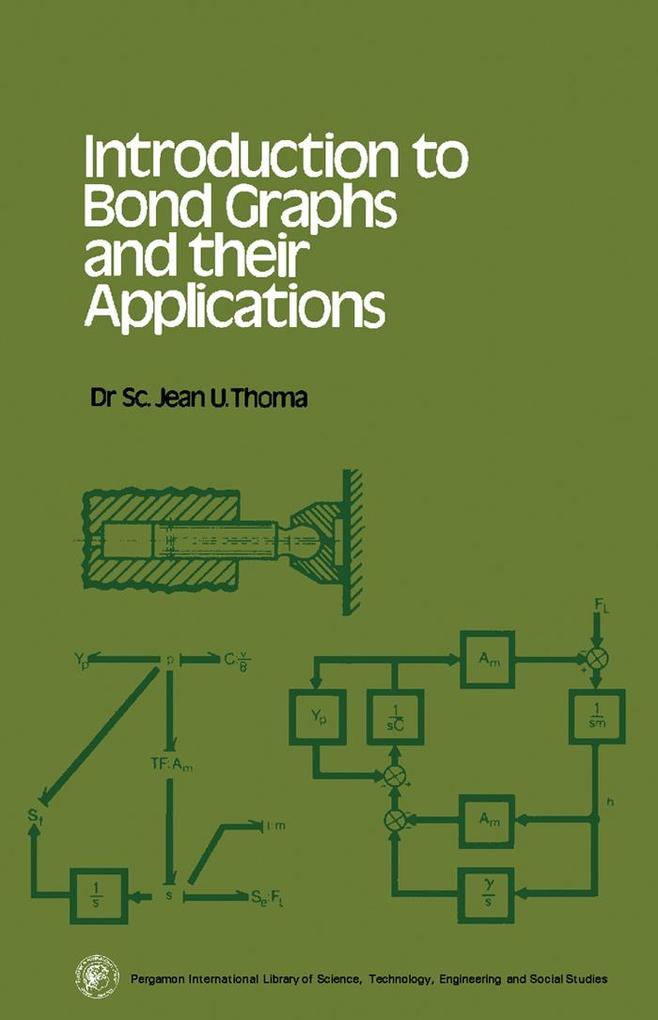
Sofort lieferbar (Download)
Introduction to Bond Graphs and Their Applications is an introductory text on bond graphs and their applications in the field of engineering. The applications of bond graphs in mechanical engineering and design, fluid mechanics, electronic data processing, and thermal and thermodynamic systems are discussed.
This book is comprised of eight chapters and begins by comparing the different kinds of graphs, diagrams, and models before turning to the fundamentals of bond graphs. The next chapter introduces the reader to the systematic application of bond graphs in mechanical engineering and design; fluid power engineering (sometimes called oil hydraulics); electrotechnique and electronics; and thermodynamics. The use of bond graphs in automatic computer programming with the ENPORT program is also described. The final chapter is devoted to inertia and resistance fields; linear two-ports in different causalities; thermodynamics of flow processes; electromechanical components; systems with distributed parameters; and force and velocity as effort or flow.
This monograph is intended primarily for all engineers interested in representing simple or complex engineering systems and should also be of value to students in the different engineering disciplines, mechanics, fluid mechanics, and electronics with electromechanical power conversion or thermodynamics.
This book is comprised of eight chapters and begins by comparing the different kinds of graphs, diagrams, and models before turning to the fundamentals of bond graphs. The next chapter introduces the reader to the systematic application of bond graphs in mechanical engineering and design; fluid power engineering (sometimes called oil hydraulics); electrotechnique and electronics; and thermodynamics. The use of bond graphs in automatic computer programming with the ENPORT program is also described. The final chapter is devoted to inertia and resistance fields; linear two-ports in different causalities; thermodynamics of flow processes; electromechanical components; systems with distributed parameters; and force and velocity as effort or flow.
This monograph is intended primarily for all engineers interested in representing simple or complex engineering systems and should also be of value to students in the different engineering disciplines, mechanics, fluid mechanics, and electronics with electromechanical power conversion or thermodynamics.
Inhaltsverzeichnis
1;Front Cover;1 2;Introduction to Bond Graphs and Their Applications;4 3;Copyright Page;5 4;Table of Contents;6 5;Preface;8 6;Introduction;10 7;Chapter 1. Diagrams, Models, and Simulation;12 7.1;1.1. Graphs and Diagrams as Representations of Engineering Systems ;12 7.2;1.2. Models for Technical Systems;14 7.3;1.3. Block Diagrams of Control Engineering and their Inversion ;15 7.4;1.4. Circuits and Equivalent Circuits;19 8;Chapter 2. Fundamentals of Bond Graphs;22 8.1;2.1. Bond Graphs with Words for Components;22 8.2;2.2. Standard Elements of Bond Graphs;25 8.3;2.3. Augmentation of Bond Graphs;34 8.4;2.4. Transformation and Simplification of Bond Graphs ;41 8.5;2.5. Additional Topics;44 9;Chapter 3. Applications from Mechanical Engineering and Design ;50 9.1;3.1. Simple Installations;50 9.2;3.2. Bond Graphs of Mechanical Drives;60 9.3;3.3. Moving Reference Points and Planetary Gear-reducers ;64 9.4;3.4. Perturbations, Losses, and Efficiencies;73 9.5;3.5. Couplings and Transmissions;77 10;Chapter 4. Fluid Mechanical Applications;80 10.1;4.1. Hydrostatic Energy Transport;80 10.2;4.2. Hydrostatic Bearings;84 10.3;4.3. Hydrostatic Control Systems and Drives;91 10.4;4.4. One-ports in Fluid Power Engineering;100 11;Chapter 5. Electronics and Electromechanical Power Conversion ;105 11.1;5.1. Electric Drive Motors;105 11.2;5.2. Bond Graphs for Electric Circuits;109 11.3;5.3. Electromechanical Signal Transducers;114 11.4;5.4. Additional Observations on Energy-storingTransducers;121 12;Chapter 6. Thermal and Thermodynamic Systems;127 12.1;6.1. Thermal Charge and Conversion Engines;127 12.2;6.2. Matter as C-field;129 12.3;6.3. Generation of Thermal Charge;134 12.4;6.4. Thermal Energy Conduction and Convection;139 13;Chapter 7. Bond Graphs and Electronic Data Processing;146 13.1;7.1. Fundamentals of Systems Simulation;146 13.2;7.2. Manual Formulation of State Space Equations ;148 13.3;7.3. The ENPORT Program ;149 14;Chapter 8. Selected Questions;153 14.1;8.1. Inertia and Resistan
ce Fields;153 14.2;8.2. Linear Two-ports in Different Causalities;158 14.3;8.3. Thermodynamics of Flow Processes;162 14.4;8.4. Electromechanical Components;167 14.5;8.5. Systems with Distributed Parameters;172 14.6;8.6. Force and Velocity as Effort or Flow;178 15;Appendix: Short Table of the Most Important Symbols;184 16;Glossary of Frequent Terms in English, French,and German;186 17;References;188 18;Index;190
ce Fields;153 14.2;8.2. Linear Two-ports in Different Causalities;158 14.3;8.3. Thermodynamics of Flow Processes;162 14.4;8.4. Electromechanical Components;167 14.5;8.5. Systems with Distributed Parameters;172 14.6;8.6. Force and Velocity as Effort or Flow;178 15;Appendix: Short Table of the Most Important Symbols;184 16;Glossary of Frequent Terms in English, French,and German;186 17;References;188 18;Index;190
Produktdetails
Erscheinungsdatum
04. Mai 2016
Sprache
englisch
Seitenanzahl
192
Autor/Autorin
Jean U. Thoma
Verlag/Hersteller
Kopierschutz
mit Wasserzeichen versehen
Produktart
EBOOK
Dateiformat
PDF
ISBN
9781483137605
Entdecken Sie mehr
Bewertungen
0 Bewertungen
Es wurden noch keine Bewertungen abgegeben. Schreiben Sie die erste Bewertung zu "Introduction to Bond Graphs and their Applications" und helfen Sie damit anderen bei der Kaufentscheidung.








